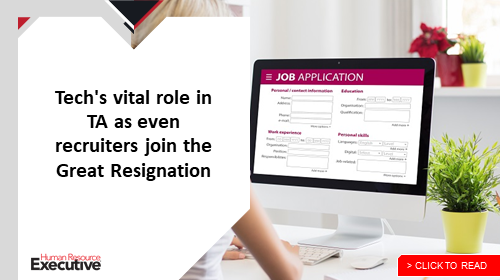HR leaders are in the strangest and most challenging environment and must adapt quickly and decisively if they are to survive and thrive in the coming months. This was the warning from HR industry analyst Josh Bersin in his keynote address about the future of the HR tech market at HR Tech Virtual.
And the pressure is on. Last November and December saw 4.1 million American workers quitting the workforce, and HR leaders must brace for more. “If this trend continues, almost one-third of your workers could leave your company,” Bersin warned.
Here are the new trends HR leaders must have on their 2022 radar to combat that exodus.
Employee experience takes over
Calling this an “urgent issue,” Bersin said HR leaders’ challenge in hiring new talent may come from within their companies. “If you are having trouble hiring, it might be because people inside are not happy and that information leaks out,” he said.
It’s not HR leaders’ fault entirely: Employee experience vendors may have over- promised their wares. “We were told by EX vendors that their solutions would make things better but that’s not true,” he said.
“If you’re not thinking of EX in your HR tech, you will run into problems,” he added.
The market for enterprise resource planning solutions—the cloud-based tools that manage operations, financials and HR activities—is “busy,” with more than 1,000 unicorns waiting to go public. And while heavyweights like Microsoft, IBM and Oracle occupy this space, new entrants are hoping to also take advantage of this market.
Vendors are finding this sector to be more complex than they thought. “Despite what vendors say, you cannot get everything from one provider,” Bersin said.
Skills taxonomies are the “next big thing”
Discovering the skills that are hidden among your employees is complex but critical. It needs to involve a companywide initiative that surveys employees about the specific talents and skills they possess.
“You need a talent intelligence office because this this cannot be done solely in learning and development and recruiting,” he said.
The skills taxonomy HR leaders build or buy will affect other functions such as learning, growth and recruiting, and it must be open to third-party data. Technology challenges hamper these efforts, he said.
See also: Why it’s time for HR to prioritize soft skills training
Recruiting and internal mobility have merged
There has been massive growth in internal mobility thanks to the Great Resignation, and HR needs to move people inside the company in “a more deterministic way,” Bersin said. Offering employees learning opportunities to fuel those moves will be a significant focus.
“One of the big ‘a-ha’ moments of 2022 is bringing learning and talent acquisition together,” he said.
Learning in the flow of work
 The history of digital learning goes back to the early days of CD-ROMs, the internet and YouTube videos, when the creators of learning experience platforms soon realized that employees don’t want spend two hours on an online course. They really want to spend 10 minutes or less on relevant content.
The history of digital learning goes back to the early days of CD-ROMs, the internet and YouTube videos, when the creators of learning experience platforms soon realized that employees don’t want spend two hours on an online course. They really want to spend 10 minutes or less on relevant content.
“I may get a little bit smarter at my job with some training but I want to know my long-term growth plan. What do I really need to learn over the next couple of years?” employees want to know, Bersin said.
Talent marketplace becomes a category
The talent marketplace, designed to fuel internal mobility, is one of the most innovative, creative, successful, fast-growing HR tech segments that Bersin has witnessed in the past three years.
“It’s growing like crazy. The vendors at the bottom that are focused in this market are all finding tremendous growth,” he said, citing tools from Gloat, Fuel50, Hitch and Workday.
“Most companies don’t spend a lot of time and planning on how to make this work,” he said. “They open up the job reqs and prepare the managers for letting people move around inside of the company, and then let it grow.”
Employee listening explodes
 HR is moving into a world of continuous listening for employees but organizations often make the mistake that listening to clients and employees are two sides of the same coin. They are wrong, said Bersin.
HR is moving into a world of continuous listening for employees but organizations often make the mistake that listening to clients and employees are two sides of the same coin. They are wrong, said Bersin.
“Employee feedback systems are designed to tell HR what’s broken and offer suggestions and feedback on why employees are thinking about leaving,” he said. They should also be used to design a rewards program and help improve workers’ lives.
For instance, Bersin said, Johnson & Johnson uses a real-time feedback system to measure employee productivity and solicit feedback. “Every time they fix a problem, they ask, ‘How well did we do to get continuously better?’” said Bersin.
Related: Insights into EX, culture and innovation top HR Tech Virtual agenda
Performance, talent and learning converge
This is a crowded and complicated area that will remain somewhat fragmented.
 “The real purpose of these systems is not just to capture [performance] appraisals but to help HR implement a closed system for performance management,” Bersin said. “Every company does this differently.”
“The real purpose of these systems is not just to capture [performance] appraisals but to help HR implement a closed system for performance management,” Bersin said. “Every company does this differently.”
Before buying this software, HR should focus on ease of use. “A lot of these performance management projects turn into a headache,” he said.
Microsoft changes HR tech forever
The software stalwart is having what Bersin called “a big impact” in the HR tech market.
Along with the wide use of Microsoft Teams during the pandemic, Microsoft Viva’s EX platform is a “hit in the market,” said Bersin, and the software giant is also acquiring smaller HR tech companies to complement its solutions, with several key tools to be rolled out later this year.
“When you have roughly 70% of large companies have Microsoft deployments already, you can turn this stuff on with almost no implementation other than configuration,” he said.
While Microsoft doesn’t offer the same capabilities as Workday, SAP or many other HR systems, HR “cannot ignore it,” he said. “They will continue to add value and get more third-party applications, and you have to take this seriously.”
The metaverse is here
In the “metaverse”—the new virtual reality-focused space for collaboration and interaction—everybody’s a developer and a creator. A recent survey found that 60% to 70% of people under the age of 40 said their life goal is to become an influencer and make money through developing content online.
 This means opportunities for HR. “We have to unleash the creativity of our employees and managers and give them opportunities to not only interact and learn but to share content, ideas and experiences,” said Bersin. For instance, companies are now offering virtual recruiting onboarding that allows recruiters and candidates to interact in a way that mimics an in-person onboarding to duplicate or mimic the entire experience.
This means opportunities for HR. “We have to unleash the creativity of our employees and managers and give them opportunities to not only interact and learn but to share content, ideas and experiences,” said Bersin. For instance, companies are now offering virtual recruiting onboarding that allows recruiters and candidates to interact in a way that mimics an in-person onboarding to duplicate or mimic the entire experience.
“I guarantee you in the fall’s HR Tech Conference, we’ll be talking about some amazing case studies in this area,” he said.
Registered attendees can watch the full session on-demand here.




